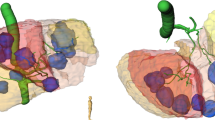Abstract
Objective
A deformable registration technique was developed and evaluated to track and quantify tumor response to radiofrequency ablation for patients with liver malignancies.
Materials and methods
The method uses the combined power of global and local alignment of pre- and post- treatment computed tomography image data sets. The strategy of the algorithm is to infer volumetric deformation based upon surface displacements using a linearly elastic finite element model (FEM). Using this framework, the major challenge for tracking tumor location is not the tissue mechanical properties for FEM modeling but rather the evaluation of boundary conditions. Three different methods were systematically investigated to automatically determine the boundary conditions defined by the correspondences on liver surfaces.
Results
Using both 2D synthetic phantoms and imaged 3D beef liver data we performed gold standard registration while measuring the accuracy of non-rigid deformation. The fact that the algorithms could support mean displacement error of tumor deformation up to 2 mm indicates that this technique may serve as a useful tool for surgical interventions. The method was further demonstrated and evaluated using consecutive imaging studies for three liver cancer patients.
Conclusion
The FEM-based surface registration technique provides accurate tracking and monitoring of tumor and surrounding tissue during the course of treatment and follow-up.
Similar content being viewed by others
References
Hargreaves GM, Adam R, Bismuth H (2000) Results after nonsurgical local treatment of primary liver malignancies. Langenbecks Arch Surg 385: 185–193
Goldberg SN, Dupuy DE (2001) Image-guided radiofrequency tumor ablation: challenges and opportunities—part I and II. J Vasc Intervent Radiol 12:1021–1032; 1135–1148
Bruix J, Sherman M, Llovet JM et al (2001) Clinical management of hepatocellular carcinoma. Conclusions of the Barcelona—2000 EASL conference, European Association for the Study of the Liver. J Hepatol 35: 421–430
Goldberg SN, Grassi CJ, Cardella JF et al (2005) Image-guided tumor ablation: standardization of terminology and reporting criteria. For the Society of Interventional Radiology Technology Assessment Committee and the International Working Group on Image-Guided Tumor Ablation. J Vasc Intervent Radiol 16: 765–778
Lu DS, Yu NC, Raman SS et al (2005) Radiofrequency ablation of hepatocellular carcinoma: treatment success as defined by histologic examination of the ex planted liver. Radiology 234: 954–960
Livraghi T, Goldberg SN et al (2000) Hepatocellular carcinoma: radio-frequency ablation of medium and large lesions. Radiology 214(3): 761–768
Charnoz A, Agnus V, Soler L (2004) Portal vein registration for the follow-up of hepatic tumors. Medical image computing and computer-assisted interventions (MICCAI). Lecture notes in Computer Science, vol 3216, pp 878–886
Carrillo A, Duerk JL, Lewin JS, Wilson DL (2000) Semiautomatic 3-D image registration as applied to interventional MRI liver cancer treatment. IEEE Trans Med Imaging 19(3): 175–185
Lorensen WE, Cline HE (1987) Marching cubes: a high resolution 3D surface reconstruction algorithm. ACM Comput Graph 2(4): 163–169
Taubin G, Zhang T, Golub G (1996) Optimal Surface Smoothing as Filter Design. In: Proceedings of the fourth European Conference on Computer Vision. Lecture notes in Computer Science, vol 1064-I, pp 283–292
Garland M, Heckbert PS (1997) Surface Simplification Using Quadric Error Metrics. In: Proceedings of the 24th conference on computer graphics and interactive techniques (SIGGRAPH), pp 209–216
Besl PJ, McKey ND (1992) A method for registration of 3D shapes. IEEE Trans PAMI 14(2): 239–256
Chui H, Rangarajan A (2003) A new point matching algorithm for non-rigid registration. Comput Vis Image Underst 89(2–3): 114–141
Gold S, Rangarajan A, Lu CP, Pappu S, Mjolsness E (1998) New algorithms for 2-D and 3-D point matching: pose estimation and correspondence. Pattern Recognit 31(8): 1019–1031
Geiger D, Girosi F (1991) Parallel and deterministic algorithms from MRFs: surface reconstruction. IEEE Trans Pattern Anal Mach Intell 13(5): 401–412
Mokhtarian F, Macworth AK (1992) A theory of multiscale, curvature-based shape representation for planar curves. IEEE Trans Pattern Anal Mach Intell 14(8): 789–805
Horn B, Hilden HM, Negahdaripour S (1998) Closed form solution of absolute orientation using orthonormal matrices. J Opt Soc Am 5(7): 1127–1135
Zienkewickz OC, Taylor RL (1989) The finite element method, 4th edn. McGraw-Hill, New York
Shewchuk JR (1996) Triangle: engineering a 2D quality mesh generator and delaunay triangulator. Applied computational geometry: towards geometric engineering of Lecture Notes in Computer Science, vol 1148, pp 203–222
Shewchuk JR (2002) Delaunay refinement algorithms for triangular mesh generation. Comput Geom Theory Appl 22(1–3): 21–74
Fung YC (1993) Biomechanics: mechanical properties of living tissues. Springer, New York
Kitamura K, Shirato H, Shimizu S et al (2002) Registration accuracy and possible migration of internal fiducial gold marker implanted in prostate and liver treated with real-time tumor-tracking radiation therapy (RTRT). Radiother Oncol 62(3): 275–281
Aspert N, Santa-Cruz D, Ebrahimi T (2002) Mesh: measuring error between surfaces using the Hausdorff distance. In: Proceedings of the IEEE International Conference on Multimedia and Expo (ICME), pp 705–708
Author information
Authors and Affiliations
Corresponding author
Rights and permissions
About this article
Cite this article
Niculescu, G., Nosher, J.L., Schneider, M.D.B. et al. A deformable model for tracking tumors across consecutive imaging studies. Int J CARS 4, 337–347 (2009). https://doi.org/10.1007/s11548-009-0298-x
Received:
Accepted:
Published:
Issue Date:
DOI: https://doi.org/10.1007/s11548-009-0298-x




